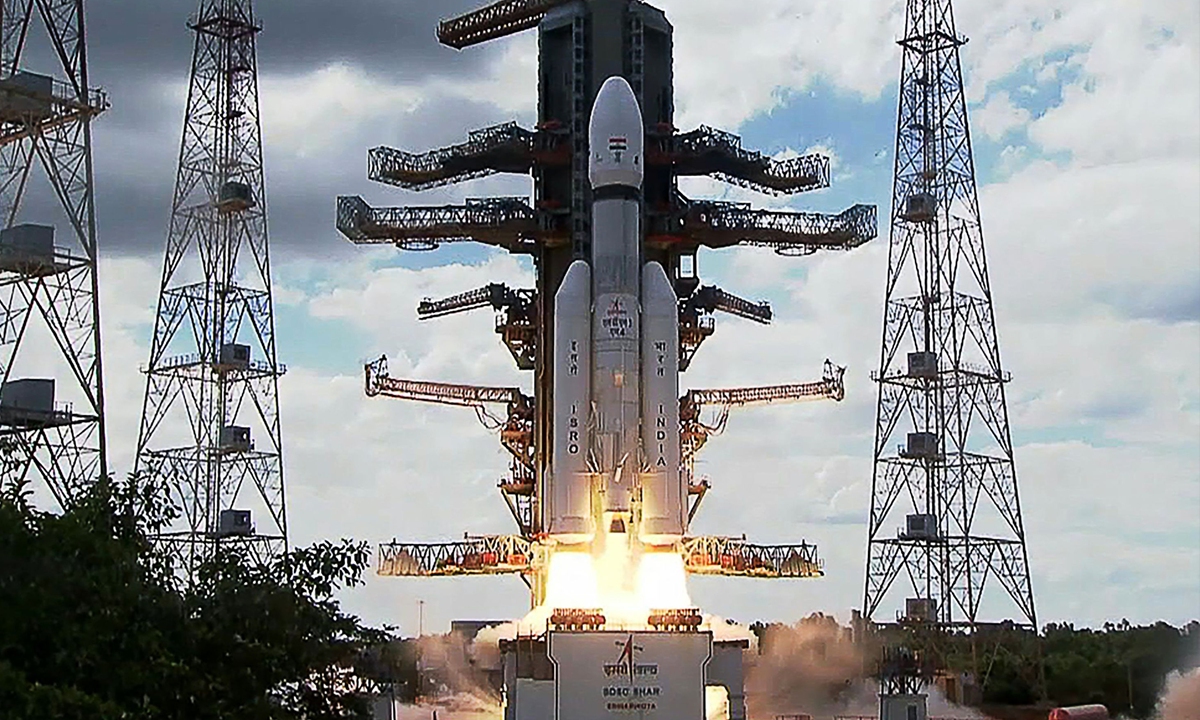
This screen grab taken from video footage from the Indian Space Research Organization (ISRO) via AFPTV on July 14, 2023 shows an ISRO rocket carrying the Chandrayaan-3 spacecraft lifting off from the Satish Dhawan Space Centre in Sriharikota, an island off the coast of southern Andhra Pradesh state. India on July 14 launched a rocket seeking to land an unmanned spacecraft on the surface of the Moon. Photo: VCG
India's Chandrayaan-3 on Wednesday became the first spacecraft to land in the lunar south pole region, making India the fourth nation to successfully land a spacecraft on the moon. India's historic landing near the Moon's unexplored south pole has won it wide congratulations across the world.
Landing on the moon's rugged south pole is full of challenges. A previous Indian bid failed in 2019 and Russia's Luna-25 failed in a similar mission less than a week ago. The soft landing of India's Chandrayaan-3 also came after nearly a month of frequent and complicated adjustment.
In addition to bringing scientific value to space exploration, Chandrayaan-3 also carries the "space ambition" of Indian Prime Minister Narendra Modi. Developing the space sector is a key plank of Modi's "Make in India" campaign, which aims to position India as an important hub for technological innovation. His administration hopes that breakthroughs in space missions can promote growth of India's manufacturing sector and the wider economy.
To realize the goal of being a frontrunner in the space arena, the Modi government in 2020 began to encourage private space launches and investment in satellite businesses.
India this year also introduced the Indian Space Policy 2023, detailing plans to boost space economy opportunities. The Modi government plans to increase India's share of the global private space launch market from 2 percent in 2020 to 10 percent over the next decade.
Chandrayaan-3 is regarded as the first major mission since the implementation of this series of policies. Its successful landing on the moon has undoubtedly boosted India's confidence in its ambition to earn a bigger share of the vast space economy.
However, the realization of India's moon landing dream, which was also full of twists and turns, does not mean it is ready to provide opportunities to India's manufacturing and overall economy. India must face the fact that there is still a long way to go.
A Bloomberg article in April titled "India is taking on China in the $447 billion space economy" said that India is muscling in on the increasingly lucrative space sector, taking advantage of the West's geopolitical isolation of China and Russia to pitch itself as a major provider of satellite launches.
Indeed, from the perspective of geopolitics, the development of India's space sector has advantages compared with China and Russia. However, India still has far to go before it can catch China. As of March 2020, China owned 13.6 percent of all earth-orbiting satellites, compared to 2.3 percent for India, according to media reporting, citing a US think tank.
While China conducted 64 launches in 2022, India managed five similar launches. In the past, India's rockets have also suffered from reliability issues. Its success rate in recent years was just about 70 percent, lower than the success rates of rockets from the US, Europe, Russia or China, according to Jonathan McDowell, an astrophysicist at the Center for Astrophysics, which is operated by Harvard University and the Smithsonian Institution, the Bloomberg said.
This time, Chandrayaan-3 has accomplished the soft landing on the moon, but some deficiencies have also been exposed during the mission, including insufficient carrying capacity, insufficient orbital accuracy, and insufficient orbit determination capabilities.
Admittedly, India has cost advantages and geopolitical advantages in commercial aerospace and broader manufacturing, but it will not be easy to turn them into a driving force for industrial and economic growth. India still faces many difficulties in seeking a bigger market share in the commercial aerospace market and high-tech manufacturing, so more extensive efforts are needed.
The author is a reporter with the Global Times. bizopinion@globaltimes.com.cn




